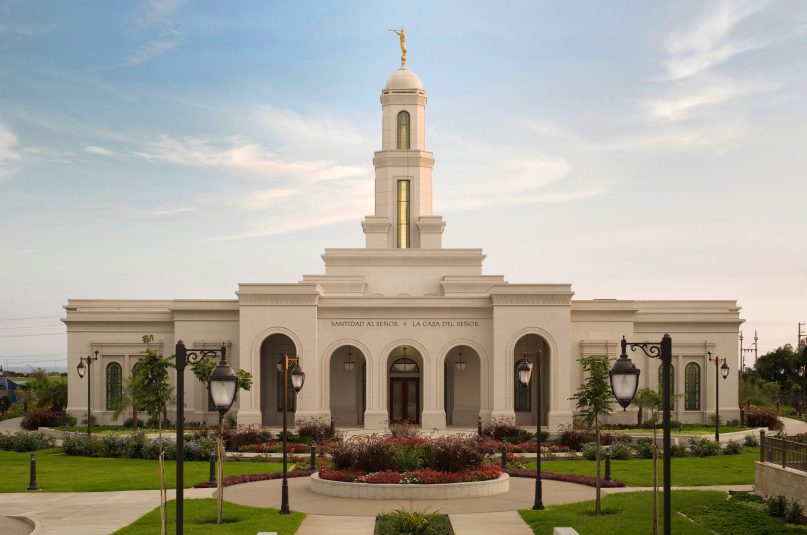(RNS) — In April, President Nelson surprised members of the Church of Jesus Christ of Latter-day Saints by announcing 20 new temples around the world. Earlier this month, he surprised us yet again, as the church decided to save the historic artwork in the Manti Utah Temple by redirecting some attendees to a brand-new temple that will be constructed in nearby Ephraim.
All told, according to the LDS Church Growth website, this will bring the total number of Mormon temples to 252, 70 of which have been announced during the nearly three and half years Nelson has led the church.
I’m of two minds about this. On the one hand, I know local members get understandably excited when they learn their area is getting a temple — particularly outside the United States, where they sometimes have to schlep to a distant city, traveling for hours or even days to reach a temple. Having more temples in far-flung locales increases the odds members can participate in temple rituals, and it helps to equalize access.
On the other hand, the church has seen years of slowing growth. Apart from a slight uptick in 2019, there has been a steady erosion, both in terms of new converts and “children of record.” Granted, the 2020 numbers reflect the unprecedented situation of the pandemic: Missionaries were recalled and church buildings shut down for part of the year. Even so, the pre-COVID trajectory of growth between 1%–2% a year was not so stellar that it would merit a 28% increase in planned temples in just the last three years.
| Year | Total membership | Difference from previous year | Percentage growth |
| 2013 | 15,082,028 | +299,555 | 2.03% |
| 2014 | 15,372,337 | +290,309 | 1.92% |
| 2015 | 15,634,199 | +261,862 | 1.70% |
| 2016 | 15,882,417 | +248,218 | 1.59% |
| 2017 | 16,118,169 | +233,729 | 1.47% |
| 2018 | 16,313,735 | +195,566 | 1.21% |
| 2019 | 16,565,036 | +251,301 | 1.54% |
| 2020 | 16,663,663 | +98,627 | .6% |
What’s more, some of these temples are hardly planned for growth areas. Consider Oslo, Norway. There are only about 4,600 church members in all of Norway, and that has been the case for at least a decade. The church is barely treading water there.
That’s also the case for a couple of the other announced sites (Belgium, with 6,600 members and a temple two hours away in the Hague, Netherlands; and Austria, with just under 4,700 members).
Those are 2019 numbers, as the church has yet to release its country-by-country figures for 2020. Generally, these are released very soon after General Conference in April. But this year, the church issued the overall statistical report on April 3, right on time, but not the individual statistics for each nation. I have contacted the Public Affairs department to ask when these will be made available and hope it is soon.
In my more cynical moments I worry they won’t be, that this one concession toward transparency — the closest thing ordinary members have to a shareholder report — could quietly disappear. It’s very hard, psychologically, for a religion that long prided itself on being the fastest-growing faith in the United States to openly concede that its trend lines are now mostly horizontal. (I would note, if I had to pen the disappointing “religious shareholder report,” that our treading water is still better than the plummeting membership many religions are experiencing right now. We may be struggling, but this market for religion simply sucks. Much of that is not our fault.)
It takes maturity to admit we’re no longer attracting and retaining members like we used to. Instead of that, we are doing what most businesses do when they’ve had a string of less than stellar years: We pivot. We emphasize the shiny new product line, which in our case is temples. Temples, temples everywhere! Let’s think positively, people!
Some day, a graduate student in media studies will write a dissertation that quantifies our positive vs. negative media coverage during this period. What I suspect they will find, just from my own trawling of Mormon news each week, is when we do get positive media coverage, a significant portion of it is related to our temples.
It’s not just members who like temples, or at least the idea of them. Temples invite curiosity from outsiders, especially in the brief period when they’re being built and then in the brief period when they are open to the public. They are a conversation-starter, a “way in,” an ongoing missionary moment.
In short, there’s a kind of perpetual Mormon optimism to our current flurry of temple-building. There’s no purely sensible reason for us to announce 70 new temples so far in Nelson’s administration. The denomination as a whole is not enjoying the kind of growth that would make these temples a need rather than a luxury, particularly since some of them are being sited in areas where Mormonism is endangered, like Western Europe.
But temples have never been about what is purely sensible. That’s all the more true lately, when they have become less a reward than a hoped-for catalyst. If yesterday’s temple was a prize bestowed on area members when they had achieved certain milestones related to growth, today’s temple is a jumper cable, a tool to re-energize the sputtering engine of the church’s numerical growth. Each announced temple represents our hope that positive community interest today could translate into converts tomorrow: “If you build it, they will come.”
But will they?
Related content:
Mormons’ petitions help save artwork in historic Manti, Utah temple
No more live endowment sessions in Mormon temples






